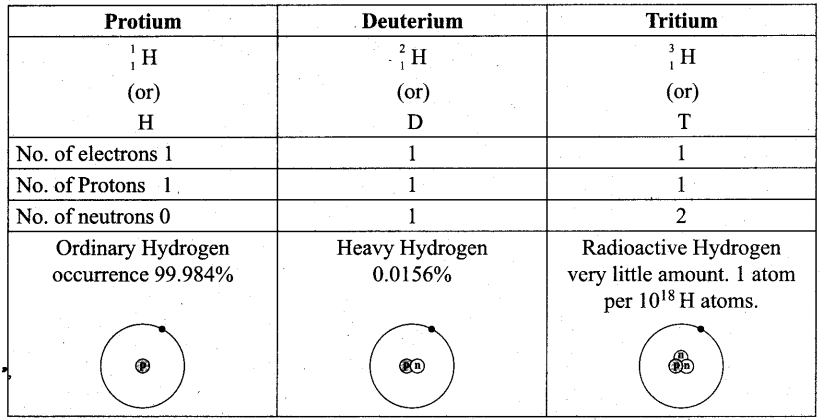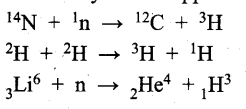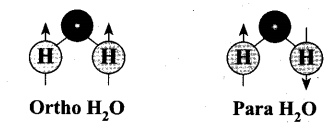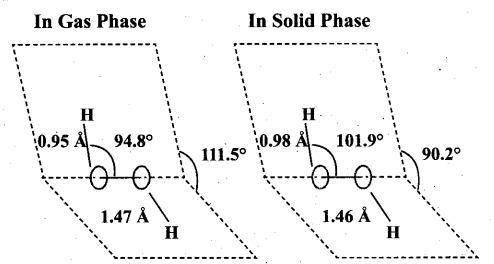Tamilnadu Samacheer Kalvi 11th Chemistry Notes Chapter 6 Gaseous State Notes
Gases at STP – H2, N2, O2, F2, Cl2, O3, He, Ne, Ar, Kr, Xe and Rn (Only 11 elements).
The Earth – The Earth is surrounded by a atmosphere of air whose composition is 78% Nitrogen, 21% Oxygen and 1% other gases.
Oxygen – It is highly essential for our survival.
Hydrogen cyanide (HCN) – Deadly poison
Carbon monoxide (CO) – Highly toxic
NO2 and SO2 – less toxic
Chemically inert gases – He, Ne, Ar, Kr, Xe and Rn.
Gas – A substance is normally in a gaseous state at ordinary temperature and pressure.
Vapour – The gaseous form of any substance that is a liquid or solid at NTP. Gaseous State
Pressure – It is defined as the force exerted by a gas on unit area of the wall.
Pressure = \(\frac{\text { Force }}{\text { area }}=\frac{\mathrm{F}}{\mathrm{a}}\)
Unit of pressure (Pascal) – 1 Pascal = 1 Nm-2,where 1 N = 1 Kg m s-2. Other units of pressure are Bar, atmosphere, Torr, mm of Hg.
Atmospheric pressure – The force exerted on a unit area of earth by the column of air above it is called atmospheric pressure.
1 atm – 760 mm Hg
Boyle’s law – At a given temperature, the volume occupied by a fixed mass of a gas is inversely proportional to its pressure.
V ∝ 1/p at constant T (or)
PV = K1 at constant T (or)
P1V1 = P2V2 = K1
Charles’ law – For a fixed mass of a gas at constant pressure, the volume is directly proportional to temperature (K).
V ∝ T and constant P and n : V/T = Constant
Absolute zero : -273.15°C.
Gay-Lussac’s law – At constant volume, the pressure of a fixed mass of gas is directly proportional to temperature. P ∝ T at constant V ; P/T = Constant.
Avogadro’s hypothesis – Equal volumes of all gases under the same condition of temperature
and pressure contain equal number of molecules.
V ∝ n (or) \(\frac{\mathrm{V}_{1}}{n_{1}}=\frac{\mathrm{V}_{2}}{n_{2}}=\text { Constant }\)
Ideal gas equation – PV = nRT where R is universal gas constant.
Values of R –
R = 0.082057 dm3 atm mol-1 K-1
R = 8.314 × Pa m3 K-1mol-1
R = 8.314 × 10-2 bar dm3 K-1mol-1
R = 8.314 JK-1mol-1
Dalton’s law of partial pressures – It states that the total pressure of a mixture of gases is the sum of partial pressures of the gases present.
Ptotal = p1+P2 + P3 ……………..
Graham’s law of Diffusion – The rate of effusion or diffusion is inversely proportional to the square of molecular mass of a gas through an orifice.
\(\frac{r_{A}}{r_{B}}=\sqrt{\frac{M_{B}}{M_{A}}}\)
Ideal gases – Gases that obey ideal gas equation PV = nRT are ideal gases.
Real gases – Gases that do not obey the ideal gas equation PV = nRT are real gases. For them either PV > nRT or PV < nRT
Van der Waals equation of state –
\(\left(\mathrm{P}+\frac{\mathrm{an}^{2}}{\mathrm{~V}^{2}}\right)(\mathrm{V}-\mathrm{nb})=\mathrm{nRT}\)
Where a and b are Van der Waals constant.
Critical constants –
Critical Volume Vc = 3b
Critical Pressure Pc = \(\frac{a}{27 b^{2}}\)
Critical Temperature Tc = \(\frac{8 \mathrm{a}}{27 \mathrm{Rb}}\)
Critical temperature of CO2 – 303.98 K
Critical Temperature – Tc is defined as the temperature below which a gas can be liquefied by the application of pressure.
Critical Pressure – Pc is the pressure required to liquefy a gas at its critical temperature.
Critical Volume – Vc is the volume occupied by one mole of a gas at its critical temperature aftd critical pressure.
Joule Thomson effect – The phenomenon of producing lowering of temperature when a gas is made to expand adiabatically from a region of high pressure into a region of low pressure.
Inversion temperature ( Ti) – The temperature below which a gas obey Joule Thomson effect is called inversion temperature. \(\mathrm{T}_{\mathrm{i}}=\frac{2 \mathrm{a}}{\mathrm{Rb}}\)






 is called carbonyl compounds. They plays an important role in the metabolic process. Carbonyl compounds are important constituents of fabrics, plastics and drugs.
is called carbonyl compounds. They plays an important role in the metabolic process. Carbonyl compounds are important constituents of fabrics, plastics and drugs.